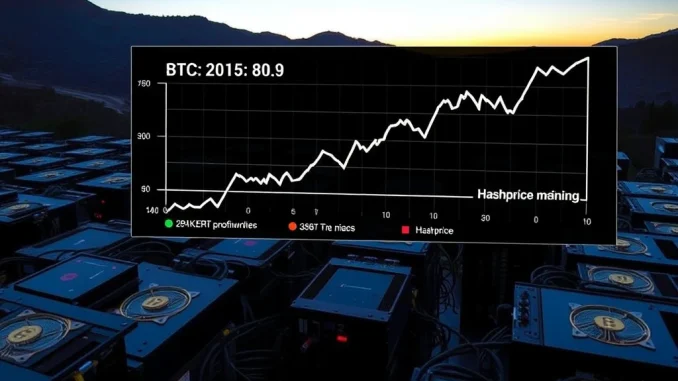
What happens when the price of Bitcoin (BTC) hits what’s reported as a new high, but the very entities securing the network are selling more than they mine? This surprising situation is currently unfolding, putting a spotlight on the complex economics facing Bitcoin miners.
Surprising Sell-Off: What Are Bitcoin Miners Doing?
Recent data reveals a significant trend: Bitcoin miners have been liquidating their reserves at an accelerated rate. According to insights from TheMinerMag, as reported by CoinDesk, miners sold off 115% of their production in April. This means they sold not only everything they mined during that month but also dipped into their existing holdings. This marks the highest sell-off rate seen since late 2022.
This aggressive selling comes despite BTC price reaching what was reported as a new high of $109,000 during that period. Traditionally, miners might hold onto Bitcoin during price rallies, anticipating further gains. The current behavior suggests underlying financial pressures are outweighing this typical strategy.
Understanding the Pressure: Weak Hashprice and High Mining Difficulty
Why are miners selling so much, even with a high BTC price? The core reasons point to declining profitability, driven by two key factors:
- Weak Hashprice: Hashprice is a metric that measures the expected revenue for a given amount of hashing power (the computational power used in mining). It’s influenced by the Bitcoin price, transaction fees, and the network’s mining difficulty. Despite the high BTC price, lower transaction fees and soaring difficulty have contributed to a relatively weak hashprice, meaning miners earn less Bitcoin for the same amount of effort and electricity cost.
- High Mining Difficulty: The mining difficulty adjusts roughly every two weeks to ensure that blocks are found consistently (about every 10 minutes). As more powerful mining hardware comes online and more miners join the network, the difficulty increases. This requires miners to expend more computational power and energy to find a block and earn the block reward (plus fees).
Combined, weak hashprice and high mining difficulty lead to reduced revenue margins for miners. This financial squeeze necessitates selling mined BTC, and sometimes even reserves, to cover operational costs like electricity, cooling, and debt servicing.
The Paradox: Major Players Continue Crypto Mining Expansion
Here’s where the situation gets interesting. While many miners, particularly smaller or less efficient operations, face significant pressure, major crypto mining firms are not retreating. Instead, many are actively expanding their operations. How are they managing this during a period of challenging profitability?
These larger companies often have better access to capital, more efficient, newer-generation mining hardware, and long-term power purchase agreements that secure lower electricity rates. Furthermore, some are leveraging their existing BTC price gains and reserves to finance the acquisition of new machines and infrastructure. They are essentially using their assets to double down on their belief in the long-term value of Bitcoin and the future of crypto mining.
This creates a bifurcated market: smaller, less capitalized miners are forced to sell and potentially exit, while larger, well-funded entities are consolidating power and increasing their share of the network’s hash rate.
What Does This Mean for the Market?
The significant sell-off by Bitcoin miners represents a notable source of supply entering the market. While the overall volume might be absorbed by demand, it’s a factor that market participants monitor closely. It indicates the current economic realities for those who secure the network and can add selling pressure, even during periods of high prices.
In Conclusion: Navigating the Mining Landscape
The current landscape for Bitcoin miners is one of contrasting forces. Despite a high BTC price, the combination of weak hashprice and soaring mining difficulty is putting significant pressure on their revenue, leading to record sell-offs. Yet, major players in the crypto mining industry are using this period to expand, betting on future profitability and network growth. This dynamic highlights the ongoing evolution and challenges within the Bitcoin mining ecosystem.



